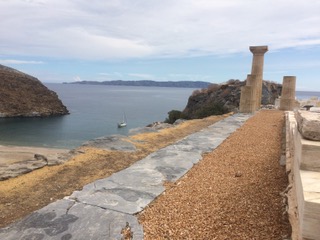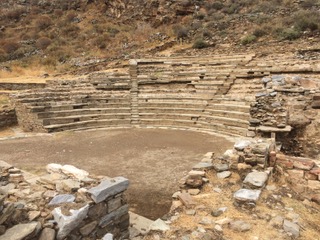37:33.425N 24:19.977E

Muskrat
Chris and Alison
Thu 25 Aug 2022 12:12
24/08/22 Kea (Polais) Weather: Stormy, thundery with heavy rain. Thunder and lightning all night, then heavy rain in the morning. Rained until early afternoon then dried up and the sun came out for a while. In the evening the wind picked up again and there were warnings of further thunderstorms. Dragged our anchor just after breakfast - Our first! We had started using the marker buoy for the anchor again and the line had somehow got wrapped around the chain and pulled the anchor out. Had to re-anchor in squally thundery conditions, The marker buoy has now been retired!! Had to wait until the afternoon to get ashore to have a look at the temples and ruins. Karthala is on the southeast coast of Kea on the bay known today as Polais. From Karthala comes most of the archaeological evidence as a result of extensive excavations carried out as early as the 19th century. The first evidence of any sort of settlement goes back to Geometric times and it is located on the southern end of the acropolis. The city (polis) was established during the Archaic period and it had a long life, continuing into early Byzantine times. The acropolis of Karthala is surrounded by a fortification wall with at least six gates. An extensive system of towers in the wall provided defence and control of the wider area. At the south end of the ridge known as Aspri Vigla are the most important buildings: the temple of Athena (late 6th/early 5th c.B.C.) at the north and the temple of Apollo (530 B.C.) to the south. Between them rises a rocky spur known as the «choregic rock». There are two other bulldings, a Propylon and Building D (early 3rd c. B.C.) on the same terrace as the temple of Athena. The theatre and part of the aqueduct system have been discovered on the south slopes of Aspri Vigla, in the Vathypotamos valley. For some reason the Romans built their baths over part of the theatre. Karthala was approached in antiquity by several roads and paths, some still used today, that connected the city with the other cities of the island and with various minor settlements.  Temple of Apollo with Muskie in the background  Temple of Athena partly reconstructed  Small ampthethetre held 800 people. |